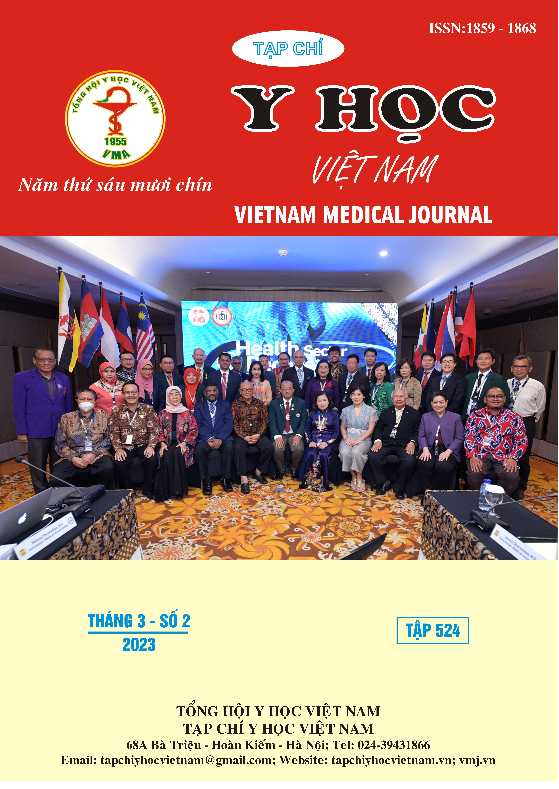ADDUCTOR POLLICIS MUSCLE THICKNESS AND MALNUTRITION IN HEART FAILURE PATIENTS
Main Article Content
Abstract
Background: Nutritional status is a topic in guidelines for management of heart failure. The adductor pollicis muscle thickness (APMT) is a new anthropometry measurement assessing muscle mass and relating to nutritional status. Objective: To determine the values of adductor pollicis muscle thickness in patients with heart failure, corressponding to malnutrition which is assessed by the subjective global assessment (SGA). Subjects and research methods: A descriptive cross-sectional study was conducted on 152 patients with heart failure at the Cardiology Department of Cho Ray hospital from May to September 2022. Results: The mean value of the dominant hand (APMTDH) was 15.2 ± 3.9mm, 13.8 ± 2.9mm for female and 16.8 ± 4.3mm for male; while that value of the non-dominant hand (APMTNDH) was 13.9 ± 3.8mm, 12.7 ± 2.9mm for female and 15.4 ± 4.0mm for male. The cut-off for APMTDH in malnutrition was 14.3mm with sensitivity of 71.6% and specificity of 67.1%, Cl 0.697-0.844 (P<0.0001); the cut-off for APMTNDH was 13mm with sensitivity of 71.6% and specificity of 65.9%, Cl 0.679- 0.829 (P<0.0001). Conclusion: The APMT may vary depending on gender, age, dominant or non-dominant hand, nutritional status, and comorbidities. The value of the male is higher than that of the female, the value of the dominant hand is higher than that of the non-dominant hand, the value of the non-malnourished group is higher than that of the malnourished group, sensitivity and specificity are average in malnourish determination.
Article Details
Keywords
Adductor pollicis muscle thickness, malnutrition, heart failure
References
2. Gonzalez MC, Duarte RR, Budziareck MB. Adductor pollicis muscle: reference values of its thickness in a healthy population. Clinical nutrition (Edinburgh, Scotland). Apr 2010;29(2):268-71. doi:10.1016/j.clnu.2009.08.012
3. Gonzalez MC, Pureza Duarte RR, Orlandi SP, Bielemann RM, Barbosa-Silva TG. Adductor pollicis muscle: A study about its use as a nutritional parameter in surgical patients. Clinical nutrition (Edinburgh, Scotland). Oct 2015;34(5): 1025-9. doi:10.1016/j.clnu.2014.11.006
4. Karst FP, Vieira RM, Barbiero S. Relationship between adductor pollicis muscle thickness and subjective global assessment in a cardiac intensive care unit. Revista Brasileira de terapia intensiva. Oct-Dec 2015;27(4):369-75. doi:10.5935/0103-507x.20150062
5. Pereira PMdL, Neves FS, Bastos MG, Cândido APC. Adductor Pollicis Muscle Thickness for nutritional assessment: a systematic review. Rev Bras Enferm. 2018 Nov-Dec 2018;71(6): 3093-3102. doi:10.1590/0034-7167-2017-0913
6. Rosário F, Giannini D, Leal V, Mourilhe-Rocha R. Adductor Pollicis Muscle Thickness as a Marker of Nutritional Status in Heart Failure. International Journal of Cardiovascular Sciences. 01/01 2018;doi:10.5935/2359-4802.20180094
7. Yoshimura da Costa T, Yukari Suganuma J, Faria S, Bernardes Spexoto MC. Association of adductor pollicis muscle thickness and handgrip strength with nutritional status in hospitalized individuals. Nutricion hospitalaria. Jun 10 2021;38(3):519-524. Asociación del espesor del músculo aductor del pulgar y la fuerza de prensión manual con el estado nutricional en individuos hospitalizados. doi:10.20960/nh.03319
8. Weschenfelder C, Salgueiro SC. Correlação entre a Espessura do Músculo Adutor do Polegar e5o Estado Nutricional. Revista Brasileira de Cancerologia. 09/28 2020;66(4):e-011044. doi:10.32635/2176-9745.RBC.2020v66n4.1044


